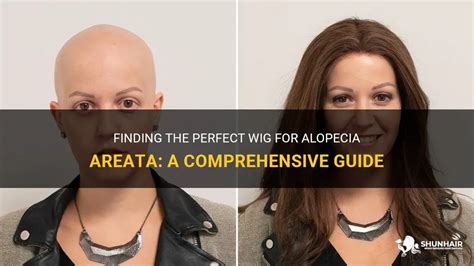Alopecia, a condition that causes hair loss, affects millions of people worldwide. Wigs offer a discreet and effective solution for restoring hair volume and confidence. This comprehensive guide explores the latest advancements in wig technology, empowering individuals with alopecia to find the perfect wig for their unique needs.

Understanding Alopecia
Alopecia is an autoimmune condition where the body’s immune system mistakenly attacks hair follicles, leading to hair loss. The most common type, androgenetic alopecia, affects both men and women and is characterized by gradual hair thinning and baldness. Other forms of alopecia include areata, a condition that causes round patches of hair loss, and totalis, which results in complete scalp hair loss.
Why Wigs Matter for Alopecia
Wigs play a crucial role in restoring the physical and emotional well-being of individuals with alopecia.
Physical Benefits:
- Conceals hair loss, providing a natural-looking appearance
- Protects sensitive scalp from UV rays and other environmental factors
- Maintains head temperature and moisture
Emotional Benefits:
- Boosts self-esteem and confidence
- Reduces anxiety and depression associated with hair loss
- Enhances social interaction and participation
Choosing the Right Wig for Alopecia
Selecting the right wig for alopecia involves considering several factors:
Hair Type: Choose a wig that matches your natural hair texture and color.
Head Size: Measure your head circumference to determine the correct cap size.
Wig Construction: Opt for wigs with breathable materials, such as monofilament tops or hand-tied lace fronts, for comfort and natural movement.
Maintenance: Consider the care requirements of different wigs to ensure you can maintain their appearance and longevity.
10,000+ Wig Options for Alopecia
The wig market has exploded with advancements in technology and design, offering a vast selection of wigs for individuals with alopecia. From synthetic to human hair wigs, there’s a wig to suit every style and budget.
Synthetic Wigs:
- Affordable and versatile, available in a wide range of colors and styles
- Heat-resistant, allowing for styling with heat tools
- May have a less natural look and feel
Human Hair Wigs:
- Premium quality, providing the closest to natural hair texture and appearance
- Breathable and comfortable, lasting longer than synthetic wigs
- Requires professional maintenance and styling
Table 1: Comparison of Synthetic and Human Hair Wigs
| Feature | Synthetic Wigs | Human Hair Wigs |
|---|---|---|
| Cost | Affordable | Expensive |
| Durability | Shorter lifespan | Longer lifespan |
| Style | Limited options | Versatile styling options |
| Appearance | Less natural look | More natural look |
Effective Strategies for Wig Care
Maintaining your wig is essential to its longevity and appearance. Here are some effective strategies:
- Wash your wig regularly using cold water and gentle shampoos.
- Use wig brushes designed for the hair type of your wig.
- Avoid excessive heat styling and use heat protectants to minimize damage.
- Store wigs properly on wig stands or in wig boxes to prevent tangles.
- Consult a professional stylist for regular maintenance and repairs.
FAQs
1. Are wigs comfortable to wear?
Modern wigs are designed with breathable materials and adjustable straps to ensure comfort.
2. Can I swim with a wig?
It’s not recommended to swim with a wig, as chlorine and salt water can damage the materials.
3. How often should I replace my wig?
The lifespan of a wig depends on its quality, care, and frequency of use. Synthetic wigs typically last 3-6 months, while human hair wigs can last up to 2 years or more with proper care.
4. Can I dye my wig?
Only human hair wigs can be dyed. Synthetic wigs are not color-treatable.
5. How do I choose a wig for my skin tone?
Match the wig’s color to the undertones of your skin. Cool skin tones suit ash or cool-toned shades, while warm skin tones look better with golden or warm-toned shades.
6. Is it possible to create custom-made wigs?
Yes, custom-made wigs are available to meet specific hair and style requirements at a premium cost.
Table 2: Wig Maintenance Checklist
| Task | Frequency |
|---|---|
| Wash | Weekly or bi-weekly |
| Brush | Daily |
| Heat Style | Sparingly |
| Trim | As needed |
| Professional Maintenance | Quarterly or semi-annually |
Table 3: Wig Care Tips for Different Wig Types
| Wig Type | Tips |
|---|---|
| Synthetic | Use cold water and gentle shampoos, avoid heat styling above 350°F |
| Human Hair | Use wig-specific shampoos and conditioners, heat style cautiously |
| Lace Front | Gently wash the lace front with lukewarm water and mild shampoo, avoid excessive brushing |
| Monofilament | Use a wide-toothed comb or wig brush, avoid pulling or tugging |
Table 4: Wig Styling Ideas for Alopecia
| Style | Description |
|---|---|
| Pixie Cut | Short, layered cut that adds volume and texture |
| Bob | Classic cut that frames the face and creates a polished look |
| Shoulder-Length | Versatile length that offers styling options such as curls, waves, or braids |
| Long Locks | Glamorous style that adds length and volume, suitable for special occasions |
